Tuesday, October 31, 2006
Time to Drool
Normally I wouldn't post something as blatantly materialistic as this, but these two items were too beautiful to keep quiet about. I need to stop reading "The New Yorker" which is where I found both of them.

The first is the Graf von Faber-Castell Walden Woods Limited Edition tribute to Henry David Thoreau, one of my favorite authors. The pen is made from historic, naturally fallen ash wood from Thoreau’s famous Walden woods and is inscribed along the barrel with a quotation from "Walden" in his original handwriting. Magnificent. It also has a magnificent $600 price tag.

But the item that has truly taken my breath away is this exquisite Breguet watch, the Classique Grande 3755PR with a spectacular interlacing of tooled, polished, rhodiumed and engraved parts. So expensive that the price is not even listed on Breguet's website, near as I can tell, it is in the neighborhood of $30,000! Absolutely breathtaking. (Click on this one for a more detailed view).
Needless to say, I won't be getting either of these for Christmas, but a man can drool can't he?

The first is the Graf von Faber-Castell Walden Woods Limited Edition tribute to Henry David Thoreau, one of my favorite authors. The pen is made from historic, naturally fallen ash wood from Thoreau’s famous Walden woods and is inscribed along the barrel with a quotation from "Walden" in his original handwriting. Magnificent. It also has a magnificent $600 price tag.

But the item that has truly taken my breath away is this exquisite Breguet watch, the Classique Grande 3755PR with a spectacular interlacing of tooled, polished, rhodiumed and engraved parts. So expensive that the price is not even listed on Breguet's website, near as I can tell, it is in the neighborhood of $30,000! Absolutely breathtaking. (Click on this one for a more detailed view).
Needless to say, I won't be getting either of these for Christmas, but a man can drool can't he?
Thursday, October 12, 2006
"What Kind of People are These?"
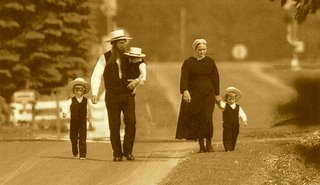
This is a spectacularly extraordinary article by a Benedictine sister by the name of Joan Chittister, a best-selling author and well-known international lecturer on topics of justice, peace, human rights, women's issues, and contemporary spirituality in the Church and in society.
I've transcribed the entire article here, or you can read it at the National Catholic Reporter where she pens the column "From Where I Stand."
"What Kind of People are These?"
by Joan Chittister
Originally published in the National Catholic Reporter
The country that went through the rabid slaughter of children at Columbine high school several years ago once again stood stunned at the rampage in a tiny Amish school this month.
We were, in fact, more than unusually saddened by this particular display of viciousness. It was, of course, an attack on 10 little girls. Amish. Five dead. Five wounded. Most people called it "tragic." After all, the Amish represent no threat to society, provide no excuse for the rationalization of the violence so easily practiced by the world around them.
Nevertheless, in a nation steeped in violence -- from its video games to its military history, in foreign policy and on its streets -- the question remains: Why did this particular disaster affect us like it did? You'd think we'd be accustomed to mayhem by now.
But there was something different about this one. What was it?
Make no mistake about it: the Amish are not strangers to violence.
The kind of ferocity experienced by the Amish as they buried the five girl-children murdered by a crazed gunmen two weeks ago has not really been foreign to Amish life and the history of this peaceful people.
This is a people born out of opposition to violence -- and, at the same time, persecuted by both Catholics and Protestants in the era before religious tolerance. Having failed to adhere to the orthodoxy of one or the other of the controlling theocracies of their home territories, they were banished, executed, imprisoned, drowned or burned at the stake by both groups.
But for over 300 years, they have persisted in their intention to be who and what they said they were.
Founded by a once-Catholic priest in the late 17century, as part of the reformist movements of the time, the Mennonites -- from which the Amish later sprung -- were, from the beginning, a simple movement. They believe in adult baptism, pacifism, religious tolerance, separation of church and state, opposition to capital punishment, and opposition to oaths and civil office.
They organize themselves into local house churches. They separate from the "evil" of the world around them. They live simple lives opposed to the technological devices -- and even the changing clothing styles -- which, in their view, encourage the individualism, the pride, that erodes community, family, a righteous society. They work hard. They're self-sufficient; they refuse both Medicare and Social Security monies from the state. And though the community has suffered its own internal violence from time to time, they have inflicted none on anyone around them.
Without doubt, to see such a peaceful people brutally attacked would surely leave any decent human being appalled.
But it was not the violence suffered by the Amish community last week that surprised people. Our newspapers are full of brutal and barbarian violence day after day after day -- both national and personal.
No, what really stunned the country about the attack on the small Amish schoolhouse in Pennsylvania was that the Amish community itself simply refused to hate what had hurt them.
"Do not think evil of this man," the Amish grandfather told his children at the mouth of one little girl's grave.
"Do not leave this area. Stay in your home here." the Amish delegation told the family of the murderer. "We forgive this man."
No, it was not the murders, not the violence, that shocked us; it was the forgiveness that followed it for which we were not prepared. It was the lack of recrimination, the dearth of vindictiveness that left us amazed. Baffled. Confounded.
It was the Christianity we all profess but which they practiced that left us stunned. Never had we seen such a thing.
Here they were, those whom our Christian ancestors called "heretics," who were modeling Christianity for all the world to see. The whole lot of them. The entire community of them. Thousands of them at one time.
The real problem with the whole situation is that down deep we know that we had the chance to do the same. After the fall of the Twin Towers we had the sympathy, the concern, the support of the entire world.
You can't help but wonder, when you see something like this, what the world would be like today if, instead of using the fall of the Twin Towers as an excuse to invade a nation, we had simply gone to every Muslim country on earth and said, "Don't be afraid. We won't hurt you. We know that this is coming from only a fringe of society, and we ask your help in saving others from this same kind of violence."
"Too idealistic," you say. Maybe. But since we didn't try, we'll never know, will we?
Instead, we have sparked fear of violence in the rest of the world ourselves. So much so, that they are now making nuclear bombs to save themselves. From whom? From us, of course.
The record is clear. Instead of exercising more vigilance at our borders, listening to our allies and becoming more of what we say we are, we are becoming who they said we are.
For the 3,000 dead in the fall of the Twin Towers at the hands of 19 religious fanatics, we have more than 2,700 U.S. soldiers now killed in military action, more than 20,600 wounded, more than 10,000 permanently disabled. We have thousands of widows and orphans, a constitution at risk, a president that asked for and a Congress that just voted to allow torture, and a national infrastructure in jeopardy for want of future funding.
And nobody's even sure how many thousand innocent Iraqis are dead now, too.
Indeed, we have done exactly what the terrorists wanted us to do. We have proven that we are the oppressors, the exploiters, the demons they now fear we are. And -- read the international press -- few people are saying otherwise around the world.
From where I stand, it seems to me that we ourselves are no longer so sure just exactly what kind of people we have now apparently become.
Interestingly enough, we do know what kind of people the Amish are -- and, like the early Romans, we, too, are astounded at it.
"Christian" they call it.
Monday, October 09, 2006
To Boldly Bid

For those of you who begged me to come back with lots of notes and pictures, this blog is for you! Feel free to click on most of the pictures for larger images. I may even have a video or two shortly!
I've never been so close to the stuff of my dreams.
When Neil woke me up Friday morning with a text message asking me if I wanted to accompany him to Christie's Auction House for the single largest Star Trek merchandise auction in history, I typed back: "Does Spock have pointy ears!?"
Not bad when your first-ever auction takes place at the famed Christies at Rockefeller Center. And when it involves your life's single largest obsession.
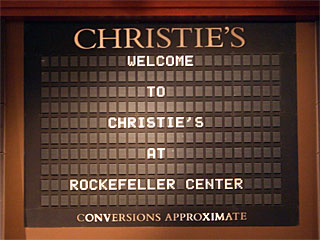
Over the course of three full days (I attended the final two), more than 1,000 lots comprising more than 4,000 items were sold. From the smallest to the largest props, furniture and set pieces, weaponry, jewelry and prosthetic items, uniforms and costumes, starship models (including the original shooting models for all the series', minus the original TV show--that one hangs in the Smithsonian), and a full-size bridge replica. And, of course, tribbles.

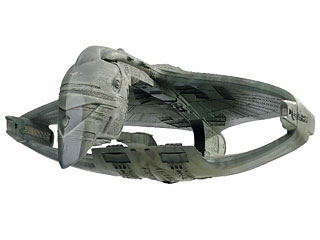
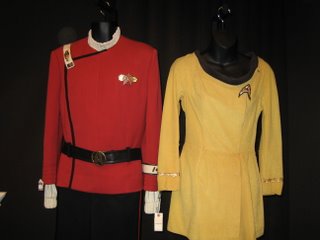

The media was everywhere, still-cameras clicking away, digital video cameras rolling. The History Channel streamed all three days live online.
Tickets to the auction floor were a precious commodity, chosen by a lottery system. (Thank you Neil and Kyrie!) I was there as a gawker, not a buyer. Almost nothing, not even the smallest item, went for less than a grand. While some items were theoretically within my reach--not that they wouldn't have taken years to pay off when coupled with my massive grad school bills--an actual uniform worn by William Shatner or Patrick Stewart would be worth four or five grand, no? Neil commented that it was a shame that this sort of once-in-a-lifetime opportunity came at such a cash-strapped stage in my life. Indeed. It was enough, I had to keep telling myself, just to be there, to actually see some of these items up close, to be a part of such a momentous event, to live vicariously through those with far larger resources than I.

Up at the front of the room, throughout the weekend, sat the Enterprise A and D. With no signs to tell me not to touch, I lovely stroked the hulls of both vessels, gliding my finger's gently along their resin skins, imagining myself as particles of stellar dust. These were not simply models of my favorite celestial chariots--they were those very chariots.
* * *
PICARD (puts his hand on the Phoenix): " It's a boyhood fantasy... I must have seen this ship hundreds of times in the Smithsonian but I was never able to touch it."
DATA: "Sir, does tactile contact alter your perception of The Phoenix?"
PICARD: "Oh, yes! For humans, touch can connect you to an object in a very personal way, make it seem more real."
DATA (also puts his hand on the ship): "I am detecting imperfections in the titanium casing... temperature variations in the fuel manifold... it is no more 'real' to me now than it was a moment ago."
TROI (observing from a catwalk): Would you three like to be alone?"
--Star Trek: First Contact
* * *
No one in that room looked at me oddly or thought me weird. I was with people who loved what I loved in the same way I loved it. We may have been a room full of misfits, but we were all misfits and we reveled in it. (For those of you who assume the auction floor must have resembled a Star Trek convention, only one bidder showed up in a full costume, but as he was British, middle-aged, bald and even resembled Patrick Stewart, he pulled it off.)
I suppose I expected the mainly British auctioneers to be stogy and staid, the paradigms of upper-class reserve. What I didn't expect was how funny they actually were, cracking dry jokes and making playful comments. This was especially true when the auctioneer was obviously not familiar with the items he or she was selling. The following are actual auctioneer comments I heard:
"Riker's...excuse me...boy toy outfit?!"
"Next lot is...Wolf's spinal column...riiiiight."
"Having just sold the Borg head, our next lot is...a Borg arm. Keep this up and we'll have a whole Borg body by the end of the night."
"Sold for $45,000. Would like to come back next week for the Monet's sir?"
"Arggg! The pirate costume!"
"Klingon wallpaper...I mean wall panel. Oh you know what I mean...I hope some of you are redecorating. This would look great in the bedroom."
"Lot 657, the Romulan Prison Camp model. Oh, booooooo, hissssssss."
"Don't look at your wife. Look at me. You don't need her permission. It's only money."
"$4000 for two tribbles. That's only 2000 a fuzz-ball! What a deal."
"Next is Dr. McCoy's medical smock. Anyone want to play doctor?"
"35,000...38,000...42,000...what in the world are we selling here!?"
"Stop that, you don't have to roll your eyes every time you bid."
"What do you mean 'No?' You've just spent $22,000...what's another $2,000!?"
"Kirstie Alley's uniform. I assume this is post Jennie Craig then...I know, I know...I'm sorry..."
"Six thousand dollars for that!? I wouldn't feel too badly that you didn't get it madam. I can make you one with my desk scraps after we're done here."
"$750 to the internet...someone out there badly needs pants. It's a good thing they're at home and not here with us. History Channel isn't that sort of cable channel."
"Lot 961...which is, if I'm not mistaken, the year we started this auction. I'm sorry, but you all look exhausted. Do I look as bad as you guys?"
More often than not, the auctioneers had no idea how to pronounce the various alien or character names, and usually just skipped them altogether. "Vulcan High Priest Kohlinahr Master's Robe" became simply, "Vulcan...robe."
"Next lot is a...er...I have no idea in hell what that is. Some alien thingymagiggy..."
Sometimes they made valiant efforts:
"Card...um,...Cardas...um, C-something-or-other self-sealing stem bolt."
"Next we have Lt. Zulu's uniform... What? Oh my, so sorry. Sulu's uniform."
Unencumbered by a bidding paddle, I enjoyed consulting my catalogue books (the real keepsakes of the weekend), trying to predict what would go for huge amounts.

It was hilarious to see the auctioneers blanch at prices they deemed absurd for what was being purchased. Pikard's Ressikan flute (from the beloved episode "The Inner Light"), estimated at $800-1,200 went for an astonishing $40,000! Even a handful of stickers that were used to simulate buttons on The Next Generation's consoles went for over a thousand dollars.

Aside from hundreds of buyers on the floor (several of whom bid on items they had no hope of procuring but wanted to be able to say they'd tried), a wall of pretty girls lined one of the walls, phones glued to their ears. Another several hovered over computer screens calling out internet bidders.
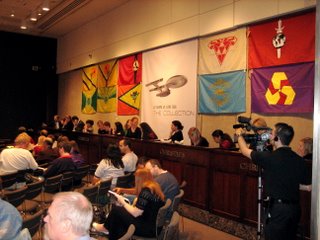
When someone in the room beat the anonymous--and apparently bottomless bankrolled--phone bidders, especially if it was for an obscenely large amount of money, the room erupted in applause. The winning bidder was oftentimes smothered by his or her (yes, there were many "hers") seatmates. Some of the larger items incited standing ovations no matter who won them.

I sat in the very back of the room and had my Mac open most of the second day (Neil had to leave after only a few hours the first day to go run his planetarium). While I was recording impressions, downloading pictures and even dabbling with a bit of homework, it occurred to me finally why so many people who passed by eyed me with curiosity and suspicion. They thought I was one of the online bidders anonymously gobbling up merchandise from those present on the floor. Emboldened, I did nothing to disabuse them of these impressions.
As big items drew closer, you could feel the air begin to crackle. People shifted forward in their seats, licking their lips in anticipation. Christies admitted the interest and energy for the show caught them completely off guard. Their catalogue estimates and the actual amount of money that came in for the items were light years apart. For instance, an item listed for $300-500 regularly went for 4 or 5 times that amount, if not more. This was the sort of event in which tens of thousands of dollars was spent in seconds.
The Enterprise-E (First Contact and Nemesis) went for $120,000 (which doesn't even take into account the 20% commission and other fees on top of that that all items are saddled with), when it was estimated to go for only $8,000-12,000. The Borg Cube, thought to draw no more than $1,500 took $80,000! The DS9 space station, with a high estimate of $12,000 went home with a $110,000 bidder!
They saved the best stuff for the last day. Saturday's items included original cast movies costumes, captain chairs, bridge set pieces, and, of course, the Enterprise-D (The Next Generation) and the ultimate item, the Enterprise-A (Original Trek movies).
The bridge set went for $30,000. When someone in the crowd called out, "That's so cheap," I had to nod my head in ready agreement.

The Enterprise-D was sold for a perfect half a million, one of the highest prices ever paid for any piece of Hollywood memorabilia.
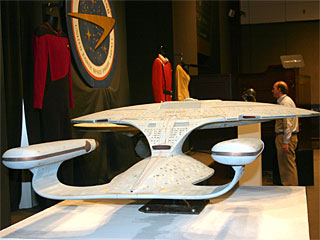

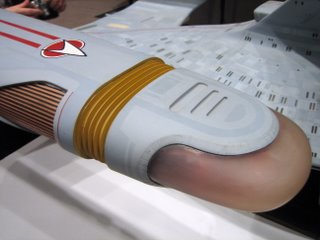
When the final bid of the auction, #1000, the Enterprise A came up, the Star Trek theme song began playing loudly over the speakers. We all rose unanimously to our feet and I'd be lying if I said I didn't have tears in my eyes. However, what began as a deeply emotional moment quickly turned into a shocking and even enraging one. Normally I would never call a quarter of a million dollars "cheap," "a steal" or "an injustice" but these are all things I said aloud when the USS Enterprise A model sold for only $240,000. We all stood dumbfounded, disbelieving what we'd just seen. The only explanation we could think of? Everyone had already spent what they had on the other 999 lots and had little left to spend on the most valuable item of the entire auction. For fraks sake, the Bird of Prey sold for more ($260,000)! Whoever will be bringing the great lady home got her for chump change and while I'm happy for them, it chaffed me the rest of the evening. It chaffs me still.
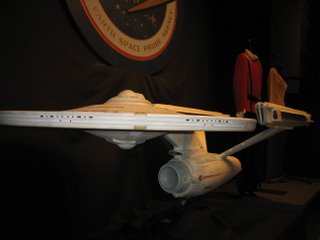
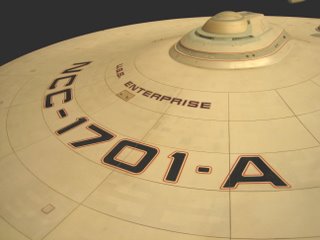
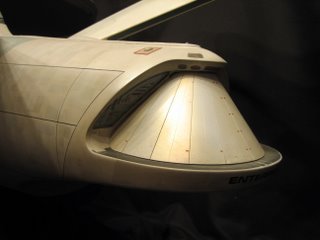
At the end of evening, after the final slide read "End of Sale," and the auctioneer invoked William Shatner's infamous Saturday Night Live line by saying, "It's over. Now go get a life," the auction drew in a stellar 7.1 million dollars--almost four times the amount Christies estimated they'd receive.
At one point I recognized Michael and Denise Okuda in the audience. Michael is Star Trek's graphic art supervisor and the technical advisor responsible for the overall look of the franchises' control panels, signage, alien written languages and computer readout animation. His wife, Denise, is a Star Trek researcher, artist and author. They'd spent the last 8 months planning this weekend. I asked them if it felt as if they were selling their children.
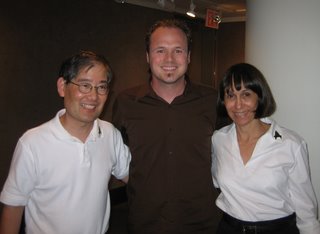
"Oh no," Denise pipped up, "Are you kidding!? These things were wasting away in crates somewhere in L.A. Now they are going to go home with fans who will lavish them with the sort of love and care they deserve. They're going to a far better place."
Though I can't take any of these things home with me, they will, of course, remain with me in my heart, where they've been all along. What an out-of-this-world weekend.
If you're interested in what some of the other items sold for, here are just a few examples:
Dixon Hill outfit: 2,800
Captain Picard's 1st season uniform: 20,000
Enterprise C: 40,000
Ferengi Shuttle: 7,300
Romulan warbird: 30,000
Cardasian Cruiser: 20,000
Ferengi Marauder: 15,000
Vulcan starship: 12,000
A replica of Kirk's original captain's chair: 9,000
Kirk's Wrath of Khan uniform: 8,500
Ilia's off-duty tunic and Deltan headband: 9,000
Spock's IV headband: 3,800
Spock's re-birth gown: 8,000
Klingon warrior custom: 8,000
Original Series Space Suit: 120,000
Battle Damaged USS Reliant: 24,000
USS Reliant: 50,000
Galileo shuttlecraft: 12,000
Regula One Space Station: 42,000
Space Dock: 65,000
Self-Destructed Enterprise: 40,000
Klingon Battlecruiser: 85,000
USS Excelsior: 110,000

Want some videos? You got it!
A close-up look at Enterprises A and D which no one at Christie's seemed to mind it we went up and touched:
Enterprise-D auction, the first $100,000:
Enterprise-D auction, the second $100,000:
Enterprise-D auction, the third $100,000:
Enterprise-D auction, the fourth $100,000:
Enterprise-D auction, the fifth $100,000:
Enterprise-D auction, "SOLD!":
Introduction of the final sale of the three-day auction, Enterprise-A:
Monday, October 02, 2006
Menage-a-trois with Mark Twain

In addition to attending the Telluride Film Festival for our first anniversary last year, my wife and I also spent the week laughing our you-know-whats off to 14 hours worth of CDs of humorist David Sedaris reading essays from his numerous books. So it seemed fitting that, for our second anniversary (postponed for a month for my wife to make it out to New York--hooray!), we should continue the menage-a-trois.
Last night, at the Count Basie Theater in Red Hook, New Jersey, we spend the evening with David...and a thousand other delighted fans as he used us as his guinea pigs, striding to the podium with a bulging manila folder tucked under his arm and testing new stories on us, unobtrusively taking notes based on our reactions.
At one point while he read hilarious excerpts from his diary, I found myself wondering if anyone would bother reading his diaries when he died. Why would they, I asked myself. That is generally only done when the dead person's diaries are of enough cultural significant that a biographer would want to include them in his research. And that's when it hit me. Well over a century ago, when people sat for similar readings by Mark Twain, did they wonder the same thing? Because, in my mind, these men are remarkably similar--authors who use humor and verbal repartee to weave stories and commentary on the human condition that is both hilarious and incisive. David Sedaris is the Mark Twain of our generation.
We stood in line to say hi and to mention that he'd unknowingly spent the past several anniversaries with us. He smiled when picking up his pen to sign one of his books we'd brought from home: "Dear Brandon and Stephanie, for your next anniversary I want you to go to Scotland."



